Jan Steemann: Modelling data in a schema free world (Talk held at Froscon, 2012-08-26)
- 1. Modelling data in a schema-free world? FrOSCon 2012-08-26 Jan Steemann (triAGENS) © 2012 triAGENS GmbH | 2012-08-26 1
- 2. About me Professional database developer @ triAGENS GmbH, Cologne, Germany Interested in all kind of databases Currently working on an open source mixed-model nosql database © 2012 triAGENS GmbH | 2012-08-26 2
- 3. Schemas in relational databases Relational databases are around for a long time already In most relational databases we can deal with these schema elements: tables relationships columns / fields views data types triggers indexes procedures / functions Schema elements are auxiliary means to organise and validate the actual data! © 2012 triAGENS GmbH | 2012-08-26 3
- 4. Normalisation in relational databases Relational databases like your data to be in a highly normalized and de-duplicated form Put simple, normalisation means dividing big entities (tables, fields) into smaller ones defining relationships between them Example data, not normalised: user_id user_name group_name status 1 foo Power user Active 2 bar Rookie Inactive 3 baz Rookie Active © 2012 triAGENS GmbH | 2012-08-26 4
- 5. Normalisation in relational databases Example data, normalised (relationships not depicted): Table „users“ Table „groups“ Table „status“ id name group status id name id name 1 foo 1 1 1 Power user 1 Active 2 bar 2 2 2 Rookie 2 Inactive 3 baz 2 1 Normalisation helps to reduce redundancies and storage requirements increase consistency and integrity Normalised data is re-arranged on retrieval using joins, projections etc. Due to normalisation, data may be fetched from several tables © 2012 triAGENS GmbH | 2012-08-26 5
- 6. Issues with relational databases Issues of relational databases: scaling is hard: This is due to the ACID (atomicity, consistency, isolation, durability) guarantees they usually provide. rigid database schemas can obstruct rapid application development: Initial and ongoing database schema development and evolution takes time, but you must do it in order to have your database accept any data at all, designing good schemas is hard fixed database schemas block deployment of changes: When deploying application changes, the database schema needs to stay in sync with the application. Deploying application changes may even cause downtime due to long-running database migrations (e.g. ALTER TABLE statements) © 2012 triAGENS GmbH | 2012-08-26 6
- 7. Issues with relational databases Some more issues: static schemas do not play well with dynamically typed languages: many languages support dynamic keys for their container types, dynamic variables, run-time typing etc. To use this with a relational database, one needs workarounds (e.g. entity-attribute value modelling, auxilliary tables) that increase complexity and make it slow saving multi-valued data is „forbidden“: Mutli-value containers (e.g. hashes, dictionaries, lists, arrays) are used frequently in programming but must not be saved in the database as such Complex workarounds are necessary to handle that saving objects can be expensive: saving one object in a relational way may create a lot of noise in relational databases (though this may be obscured by frameworks) © 2012 triAGENS GmbH | 2012-08-26 7
- 8. NoSQL databases – why? In the past 5 years, many new database products have emerged The common term for these new products is „NoSQL“ databases, mainly interpreted as „not only SQL“ „non-relational“ is also a good name for them because almost no NoSQL database follows the relational model Instead, most NoSQL databases overcome specific issues that relational databases have, especially scaling schema rigidity © 2012 triAGENS GmbH | 2012-08-26 8
- 9. NoSQL databases – scaling Scaling problems of relational databases are addressed in most NoSQL databases by reducing ACID guarantees and removing relational features: Atomicity is guaranteed only for some operations, not all Isolation is only guaranteed for some operations Strict consistency is relaxed to eventual consistency Strict durability is normally turned off (but is configurable by admin) Don't offer referential integrity or do not enforce it Complex data operations as joins etc. are highly restricted or completely disallowed These measures help to reduce locking and synchronisation overhead and make scaling possible at all © 2012 triAGENS GmbH | 2012-08-26 9
- 10. NoSQL databases – schema rigidity Most NoSQL databases lift the requirement of having to define explicit database schemas: Some NoSQL databases don't use schemas at all, they are fully schema-free Some require the user to only predefine highest level schema elements (e.g. databases, collections, column families) upfront (and some allow it as you go) Some use schemas implicitly by analysing incoming data, using dynamic schemas for each data element inserted instead of predefined schemas Benefits: Less time spent on upfront schema development and ongoing schema evolution, more time can be used for actual application development Can store and retrieve programming language objects more easily No need to sync application changes deployment with database schema changes, no database downtime required for schema modifications © 2012 triAGENS GmbH | 2012-08-26 10
- 11. NoSQL databases – overview There is a multitude of different NoSQL databases around http://nosql-databases.org/ currently lists 122 NoSQL databases Some of the most popular ones: MongoDB Riak CouchDB Redis RavenDB Tokyo Cabinet Hadoop Voldemort Hypertable Neo4j Cassandra OrientDB SimpleDB InfiniteGraph They are all different, but a basic categorisation follows © 2012 triAGENS GmbH | 2012-08-26 11
- 12. NoSQL databases – categorisation Key-value stores: key value Map value data to unique string keys (identifiers) obj3 „{ a: 1, b: 1 }“ Allow access to data by key only obj1 „{ a: 2, b: 1 }“ Treat data as opaque (data has no schema) obj2 „{ a: 1, b: 2 }“ Do not save keys in predicatable order numUsers „25“ Sometimes disallow key enumeration because it is expensive userIds „1, 2, 3, 4“ May have one or multiple key spaces to logically similar group keys Can implement scaling and partitioning easily due to simplistic data model © 2012 triAGENS GmbH | 2012-08-26 12
- 13. NoSQL databases – categorisation Key-value store extensions (containers, counters, expiration): may allow querying on value data, too, by offering secondary indexes. secondary index values must be provided by application because store still treats data as opaque (data has no schema) may offer atomic container operations, counters (e.g. inc / dec) or value expiration features that allow broader queries and use cases key value index on „a“ atomic operations obj3 „{ a: 1, b: 1 }“ 1 obj1 „{ a: 2, b: 1 }“ 1 obj2 „{ a: 1, b: 2 }“ 2 numUsers „25“ increment userIds „1, 2, 3, 4“ add 5 to set © 2012 triAGENS GmbH | 2012-08-26 13
- 14. NoSQL databases – categorisation Ordered key-value stores: Co-locate values with adjacent keys so keys are stored sorted Also allow range queries on keys Still treat value data as opaque (data has no schema) key value prj1_cnt „25“ prj1_user1 „{ a: 2, b: 1 }“ prj1_user2 „{ a: 1, b: 2 }“ prj2_cnt „42“ prj2_user1 „{ a: 5, b: 1 }“ prj2_user2 „{ a: 1, b: 3 }“ © 2012 triAGENS GmbH | 2012-08-26 14
- 15. NoSQL databases – categorisation Wide column stores: Save values in an n-level map-of-maps substructure, e.g. column families, supercolumns and columns with value & timestamp Allow querying specific attributes for keys (at least at the top levels) key columns user1 name: „foo“ city: „bar“ user2 name: „bar“ city: „baz“ work: „foo“ user3 name: „baz“ key supercolumns columns user1 address city: „bar“ street: „foo“ name first: „foo“ last: „bar“ © 2012 triAGENS GmbH | 2012-08-26 15
- 16. NoSQL databases – categorisation Document stores: Normally based on key-value stores (each document still has a unique key) Allow to save documents with logical similarity in „databases“ or „collections“ Treat data records as attribute-structured documents (data is no more opaque) Use inherent schemas of documents to categorise attributes and sub-attributes Introduce data types (primitive types, compound types) Allow arbitrary nesting and document complexity using lists, arrays etc. Allow individual documents to have different attributes, even if in same collection Often allow querying and indexing document attributes © 2012 triAGENS GmbH | 2012-08-26 16
- 17. NoSQL databases – categorisation Example documents in a document store: key attributes and sub-attributes user1 address city: „bar“ street: „foo“ name: „foo“ birthday month: 12 day: 1 year: 1983 likes „skiing“ „fishing“ avgScore: 3.5 user2 address city: „baz“ street: „foobar“ name: „bar“ user42 banana: true © 2012 triAGENS GmbH | 2012-08-26 17
- 18. NoSQL databases – categorisation Graph databases: Often based on key-value or document stores Additionally save relationships (edges) between documents (vertices) Allow querying relationships between documents Relationships can have attributes as well user1 name: „foo“ user2 name: „bar“ age: 32 age: 35 rated value: 3 rated value: 5 © 2012 triAGENS GmbH | 2012-08-26 18
- 19. Caveat emptor Things you should be aware of when using a NoSQL database: multi-query, multi-document or multi-key „transactions“ may not be atomic and not be isolated the application may need to handle inconsistent / stale reads the application may need to resolve version conflicts or handle multiple schema versions of documents referential integrity needs to be enforced by the application if the datastore treats data as opaque, it will not at all validate it by design, the database may not be able to answer some classes of queries, e.g. joins need to be performed by the application, not by the database Put simple: database will do less, application must do more! © 2012 triAGENS GmbH | 2012-08-26 19
- 20. Which datastore to use? Relational databases are still a good fit for many problems, but not for all The same is true for NoSQL databases Each category of NoSQL databases and each individual product has its own sweet spots (and downsides) Check what you want to achieve first, then pick the right tool(s) for the job It may make sense to use different databases in parallel © 2012 triAGENS GmbH | 2012-08-26 20
- 21. Why care about data modelling in NoSQL? Even in NoSQL databases, your data will have some structure This effective data model determines the consistency level you're able to achieve the retrieval and update performance the storage space required for saving the data the types of queries you will be able to run on the data So even if you don't define explicit schemas, you still need to care about structuring your data properly © 2012 triAGENS GmbH | 2012-08-26 21
- 22. Some NoSQL data modelling considerations Data modelling for schema-less or dynamic schema datastores is different than modelling for relational databases Different NoSQL databases require different modelling The techniques to apply are not revolutionary, but in the relational world they are unnecessary or even anti-patterns A few things to look at: Proper key and attribute naming Building „indexes“ by hand for aggregation Data denormalisation and duplication © 2012 triAGENS GmbH | 2012-08-26 22
- 23. Picking „good“ keys – key length In plain key-value stores, keys are the only thing that you can query Keys are also present in other categories of NoSQL databases. Data elements are still identified using unique keys Keys should be picked so that they are sensible and legible Keys are normally stored just once, but... ...in some NoSQL databases, key values may be duplicated a lot of times in secondary indexes, append-only log structures etc. In these situations, keys should also be as short as can be tolerated to not waste disk space / RAM © 2012 triAGENS GmbH | 2012-08-26 23
- 24. Key length – CouchDB example Case: insert 1000 documents with unique keys into vanilla CouchDB Key prefix is „very-long-id“ For each document, we also store an attribute named „very-long-value“ Setup: for i in `seq 1000 1999` do curl -X POST --header "Content-Type: application/json" --data "{ "_id": "very-long-id-$i", "very-long-value": "$i" }" http://127.0.0.1:5984/keytest done © 2012 triAGENS GmbH | 2012-08-26 24
- 25. Key length – CouchDB example Now check how often the key prefix occurs in the datafile: strings /db/keytest.couch | grep -c "very-long-id" strings /db/keytest.couch | grep -c "very-long-value" Results: the non-key attribute name „very-long-value“ is saved 1,000 times the key prefix is stored 42,492 times instead of the expected 1,000 times !! This is due to MVCC that organises data in copy-on-write B+ trees © 2012 triAGENS GmbH | 2012-08-26 25
- 26. Picking „good“ keys – hierarchical keys If in a key-value store only one global keyspace is available, use „hierarchical keys“ to distinguish keys from multiple applications or multiple users. This helps preventing unintended key collisions. Avoid these keys: Instead, use such keys: user1 app1_user1 profile42 client6_profile42 item23 app1_client6_item23 If your datastore allows efficient key enumeration with prefixes, this also allows hierarchical operations by prefix, e.g. DELETE client6_*, GET app1_client6_item* Don't need this in document stores due to collections © 2012 triAGENS GmbH | 2012-08-26 26
- 27. Attribute names in value data The value data you save is often a combination of attribute names and values, e.g. { „age“: 35, „gender“: „m“, „name“: „foo“ } In a fully schema-free datastore (e.g. plain key-value store), the store treats data as opaque and cannot tell attribute names and values in the value data apart In document stores, data is no more opaque. However, there are no fixed schemas. Each document, even if in the same collection, could have different attributes This means non-key attribute names are saved redundantly for EACH record/document Result: using attribute name „f“ will normally result in much lower disk footprint than using attribute name „firstName“. Check these MongoDB-specific links: © 2012 triAGENS GmbH | 2012-08-26 27 http://christophermaier.name/blog/2011/05/22/MongoDB-key-names
- 28. Aggregation – home-made indexes NoSQL stores normally don't support aggregation queries, but you can workaround that by creating „index“ keys on your own. Initial data: key value user1 „{ state: „CA“, age: 35 }“ user2 „{ state: „CA“, age: 26 }“ user3 „{ state: „FL“, age: 21 }“ user42 „{ state: „FL“, age: 39 }“ From that you can derive „index“ keys that provide users by state. You can now run count queries easily: users_CA „user1, user2“ users_FL „user3, user42“ © 2012 triAGENS GmbH | 2012-08-26 28
- 29. Aggregation – home-made indexes „Index“ keys that provides users by age: key value users_39 „user42“ users_35 „user1“ users_21 „user3“ users_26 „user2“ Can also directly aggregate categories in „index“ keys if there are (too) many distinct category values: users_20_29 „user3, user2“ users_30_39 „user1, user42“ (I know, I should have used better key names) © 2012 triAGENS GmbH | 2012-08-26 29
- 30. Aggregation – home-made indexes Home-made „indexes“ provide about the same functionality as materialised views do in relational databases And as in materialised views, this means data duplication! The database won't maintain the „indexes“ for you, so you have to maintain them yourself (from out of the application) Keeping the „indexes“ up-to-date may require data updates in several places Can easily get ouf of sync or provide an inconsistent view of the data Accuracy may still be good enough, but this depends on the use case © 2012 triAGENS GmbH | 2012-08-26 30
- 31. Aggregation – hierarchical keys If your datastore allows efficient key range enumeration using leftmost prefix queries, using hierarchical „index“ keys can also be used for multi-dimensional aggregation key query Americas_CA_Toronto Americas_US_New York Asia_CN_Beijing Query: GET Asia_* Asia_TW_Taipeh key Europe_DE_Berlin Query: GET Europe_* Europe_DE_Cologne Europe_FR_Paris Query: GET Europe_FR_* Europe_FR_Toulose © 2012 triAGENS GmbH | 2012-08-26 31
- 32. Aggregation – key buckets If the datastore does not allow querying attribute values, buckets with predictable key names can be used to support aggegation Example case: users online on a website during the last x minutes Key name convention: „usersOnline_${slot}“, with ${slot} being slot = (time() / 60).floor() * 60 (the current Unix timestamp rounded to a 60 second slot) This will produce predictable key names such as usersOnline_1345732920 usersOnline_1345732980 UsersOnline_1345733040 You can now easily save and query which users were online in which time slot and create reports © 2012 triAGENS GmbH | 2012-08-26 32
- 33. Denormalisation – nesting sub elements It may be beneficial to all nest sub elements of a logical unit in the unit itself instead of saving the sub elements separately Document stores are built for exactly this case (nesting attributes), but this pattern can be used in key-value stores as well Instead of saving all sub elements individually key value user1_name ... user1_address ... user1_likes ... Can store all sub elements of a user in one key / document only: user1 { name: ..., address: ..., likes: .... } © 2012 triAGENS GmbH | 2012-08-26 33
- 34. Denormalisation – nesting sub elements Benefit: nesting sub elements reduces the number of elements that keep data for a logical unit (here: „user“) This reduces the number of read / write operations for each unit Accessing data of a single key is normally an atomic operation, so nesting prevents sub elements from getting out sync, avoiding inconsistent reads and writes of logical units In NoSQL databases, nesting is also a natural way to avoid joins, which are not offered by most NoSQL products © 2012 triAGENS GmbH | 2012-08-26 34
- 35. Denormalisation – nesting sub elements Downside: nesting will increase the data volume stored for each key, increasing the overhead for each read and write in both the datastore and the application If you overdo nesting, you might end up having the same data stored in multiple places, and no clear responsibility for it This will waste space and cause consistency issues For example, a change to user2's „likes“ attribute requires 3 writes: key value user1 { likes: [ ... ], friends: [ { user2: { likes: [ ... ] } }, user15: { likes: [ ... ] } }, ... ] } user2 { likes: [ ... ], friends: [ { user67: { likes: [ ... ] } }, user1: { likes: [ ... ] } }, ... ] } user15 { likes: [ ... ], friends: [ { user2: { likes: [ ... ] } }, user99: { likes: [ ... ] } }, ... ] } © 2012 triAGENS GmbH | 2012-08-26 35
- 36. Denormalisation – nesting sub elements Instead of nesting such elements fully, prefer referencing them by key / id: key value user1 { likes: [ ... ], friends: [ user2, user15 ] } user2 { likes: [ ... ], friends: [ user67, user1 ] } user15 { likes: [ ... ], friends: [ user2, user99 ] } This will allow you to update data in only one place, saving storage space and improving consistency The price you pay: to retrieve all details for the referenced items, you now need additional read operations © 2012 triAGENS GmbH | 2012-08-26 36
- 37. Summary Data modelling for NoSQL databases is different than for relational databases: Instead of normalising your schema, you'd rather denormalise your data Data duplication is common to support analysis and aggregation queries, and for fast retrieval Different NoSQL databases have different features and to be used effectively, may require different data models To make best use of a specific store, you should have some knowledge about how it organises data internally and what guarantees it provides: Atomic operations should be exploited where possible to improve consistency Cross-record/document consistency is mostly not guaranteed. If your store at all offers it, it will be slowed down by it © 2012 triAGENS GmbH | 2012-08-26 37 In general logic is moved from the database to the application
- 38. Misc NoSQL user group Cologne: every 1st Wednesday / month http://www.nosql-cologne.org/ NoSQL matters conference Barcelona: October 6th, 2012 http://www.nosql-matters.org/ ArangoDB 1.0 release: September 2012 http://www.arangodb.org/ © 2012 triAGENS GmbH | 2012-08-26 38










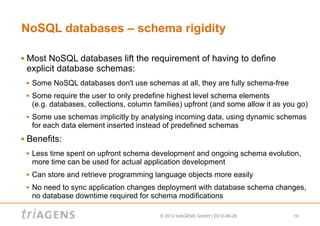








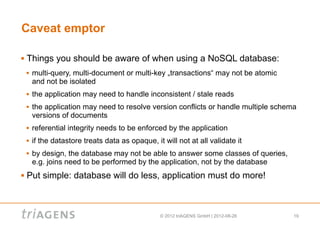
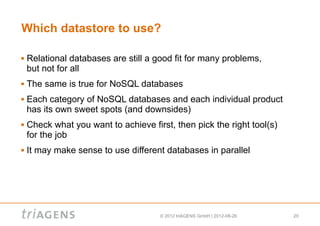





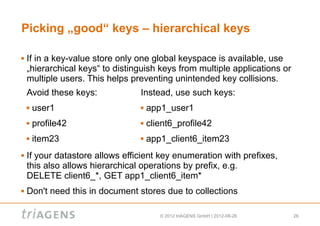

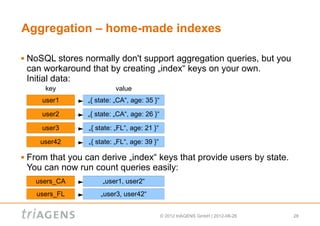






![Denormalisation – nesting sub elements
Downside: nesting will increase the data volume stored for each key,
increasing the overhead for each read and write in both the datastore
and the application
If you overdo nesting, you might end up having the same data stored
in multiple places, and no clear responsibility for it
This will waste space and cause consistency issues
For example, a change to user2's „likes“ attribute requires 3 writes:
key value
user1 { likes: [ ... ], friends: [ { user2: { likes: [ ... ] } }, user15: { likes: [ ... ] } }, ... ] }
user2 { likes: [ ... ], friends: [ { user67: { likes: [ ... ] } }, user1: { likes: [ ... ] } }, ... ] }
user15 { likes: [ ... ], friends: [ { user2: { likes: [ ... ] } }, user99: { likes: [ ... ] } }, ... ] }
© 2012 triAGENS GmbH | 2012-08-26 35](https://image.slidesharecdn.com/jansteemanntalkfrosconmodellingdatawithoutschema20120827-120827041951-phpapp01/85/Jan-Steemann-Modelling-data-in-a-schema-free-world-Talk-held-at-Froscon-2012-08-26-35-320.jpg)
![Denormalisation – nesting sub elements
Instead of nesting such elements fully, prefer referencing them by
key / id:
key value
user1 { likes: [ ... ], friends: [ user2, user15 ] }
user2 { likes: [ ... ], friends: [ user67, user1 ] }
user15 { likes: [ ... ], friends: [ user2, user99 ] }
This will allow you to update data in only one place,
saving storage space and improving consistency
The price you pay: to retrieve all details for the referenced items, you
now need additional read operations
© 2012 triAGENS GmbH | 2012-08-26 36](https://image.slidesharecdn.com/jansteemanntalkfrosconmodellingdatawithoutschema20120827-120827041951-phpapp01/85/Jan-Steemann-Modelling-data-in-a-schema-free-world-Talk-held-at-Froscon-2012-08-26-36-320.jpg)

